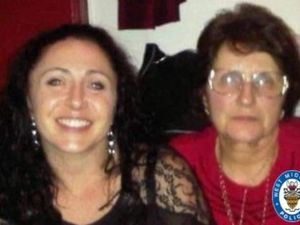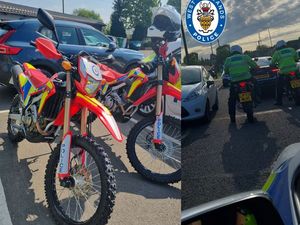Ukrainian student in one man racist reign of terror targeting Black Country mosques
It was a 90-day nightmare during which one man was knifed to death and many more could have been killed or injured as mosques were blasted with bombs.

Twisted Ukrainian racist Pavlo 'Pasha' Lapshyn launched the terrifying hate campaign as soon as he arrived in Birmingham on a work scholarship.
Five days after setting foot in this country the postgraduate engineering student knifed Mohammed Saleem three times in the back as the 82-year-old victim walked home from evening prayers.
Then the 25-year-old self-styled white supremacist embarked on a bombing campaign that targeted mosques in an escalating offensive designed to stir up racial conflict.
Man pleads guilty to Black Country mosque blasts and murder
Mr Saleem died because he was Asian and walking alone near his Small Heath home when spotted by knife-wielding Lapshyn who later told detectives that the random attack was launched because the victim 'was a Muslim and there were no witnesses'. Detective Superintendent Shaun Edwards, from the West Midland Counter Terrorism Unit, concluded: "He was just in the wrong place at the wrong time."
Others were more fortunate as sheer luck allowed them to escape unscathed from one of the blasts because the Kanzul Iman Central Jamia Mosque in Binfield Street, Tipton forgot to update their website with news that prayers were being held an hour later than usual on the first Friday of Ramadan.
If they had taken place at the normal time many of the 200 strong congregation are likely to have been in the line of fire when a bomb made by Lapshyn sent a deadly shower of nails sweeping across the car park, hurling debris in a 70m circle.
The rabid racist had detonators and chemicals for at least three more bombs but was caught before he could strike again thanks to a mixture of hi-tech investigative skills and good old fashioned police work.
Lapshyn quickly admitted detonating the explosions at the Kansul Iman mosque in Tipton and making and planting a bomb that blew up at the Aisha Mosque and Islamic Centre in Rutter Street, Walsall in a blast that hurt nobody three weeks earlier. The Ukrainian then volunteered that he had also been responsible for making and planting another bomb that exploded outside Wolverhampton Central Mosque. Two days after his arrest he also confessed to killing Mr Saleem.
The defendant, who speaks three languages, replied when asked for the motive for the bombings: "Racism." He then explained: "I would like to increase racial conflict because they are not white and I am white."
He revealed he had intended to 'hurt' people in the Tipton blast before adding: "I have a racial hatred, so I have a motivation, a racial motivation."
Mr Edwards commented: "He was an extremely dangerous man who was calm, calculated and committed. I do not have a theory on what triggered all this because I am a detective and not a psychologist." One suggestion is that Lapshyn had plotted to launch the attacks before arriving in Britain on April 24. He had known he had won the place since 2011 when he was awarded the placement at top technology company Delcam in Small Heath for his work as a PhD student at the National Metallurgical Academy of Ukraine.
There was plenty of time to prepare after being presented with the prize by the then British Ambassador to the Ukraine Leigh Turner and there is evidence he had researched Birmingham but did not start checking mosques until after his arrival. He never visited EDL or BNP websites.
Lapshyn got a Bachelor of Arts degree with honours in the technology of machine building in 2009 and the following year achieved a Masters degree in the same subject but the star student also had a dark side. He was known to the police in his home country and was fined in August 2010 after unsuccessfully testing explosives in his flat.
British detectives are still in the Ukraine piecing together details of his life in that country as they search for further clues to what turned him into a violent racist.
His mother was badly hurt in a car accident in March this year shortly before he left for Birmingham but police have ruled this out as a possible trigger for the outrage.
He stabbed Mr Saleem to death on April 29, three months before the birth of the 23rd grandchild of the victim whose daughter, Shazia Khan, 45, said: "It was an act of terrorism because he was killed for his faith. It was so shocking for him to lose his life in such a brutal way."
Lapshyn then spent almost two months buying chemicals, mobile phones and other equipment needed for the bombings. These were purchased via the internet and from a local supermarket and market stalls.
Analysis of his computer disclosed he also closely followed news reports on the hunt for the killer of Mr Saleem and used Google maps to pinpoint the mosques he had targeted while checking the best bus routes to get there. He also read the Turner Diaries, a 1970s right wing revolutionary tract.
The bomber claimed to have learned to make the explosive devices that were used from the internet and also scoured it for information about right wing extremism and white supremacists. Despite that detectives are convinced he was acting alone, was not a member of any extremist group and had not been sent to this country to launch the attacks by anybody else.
On May 21 he added a video to his social network site of Timothy McVeigh who was executed after detonating a car bomb in Oklahoma City killing 168 people in April 1995. Four days later the Ukrainian killer posted a video of Hitler Jugend training and followed by a picture of a detonator element.
Early on June 21 Lapshyn posted a picture of McVeigh hours before launching a bomb attack on the Aisha Mosque.
Police were not notified for almost 24 hours after people had discovered various bits from an explosive device. Around 150 people were evacuated from their homes as experts discovered that the bomb had been put by some gates a short distance from the mosque. The remains of the child's lunch box in which the device had been placed were also found. This was to play a vital role in tracing the culprit.
Seven days later on June 28 another small explosive device exploded on a roundabout close to Wolverhampton Centre Mosque in Whitmore Reans. A member of staff reported hearing a loud bang and seeing smoke coming from the traffic island. A local officer was sent up to investigate but could find nothing untoward.
Finally on July 12 came the nail bomb attack at the Kanzul Iman Central Jamia Mosque where the device packed with 600 grams of 25 mm nails was detonated on a bank by a stretch of disused railway line behind the mosque. Analysis of the computer of Lapshyn after his arrest showed he had checked the website of the mosque which had not been updated with the correct time of prayers and so timed the bomb to explode an hour before people arrived.
After the arrest of Lapshyn several bottles of the chemicals needed to produce HMTD – the home made explosive involved in the mosque blasts – were discovered in the room where he lived along with the coffee grinder used to make the bombs and three mobile phones, each adapted in the same way as a phone had been used to detonate the Walsall mosque blast.
He carried the bombs to their destinations by bus but did not set the timers until he was there.
Denis Negreba, 22, another Ukrainian student, who shared the same room was released without charge after detectives discovered he played no part in the plot.



